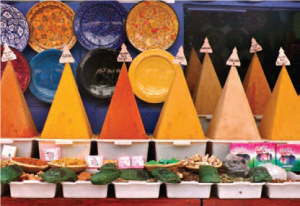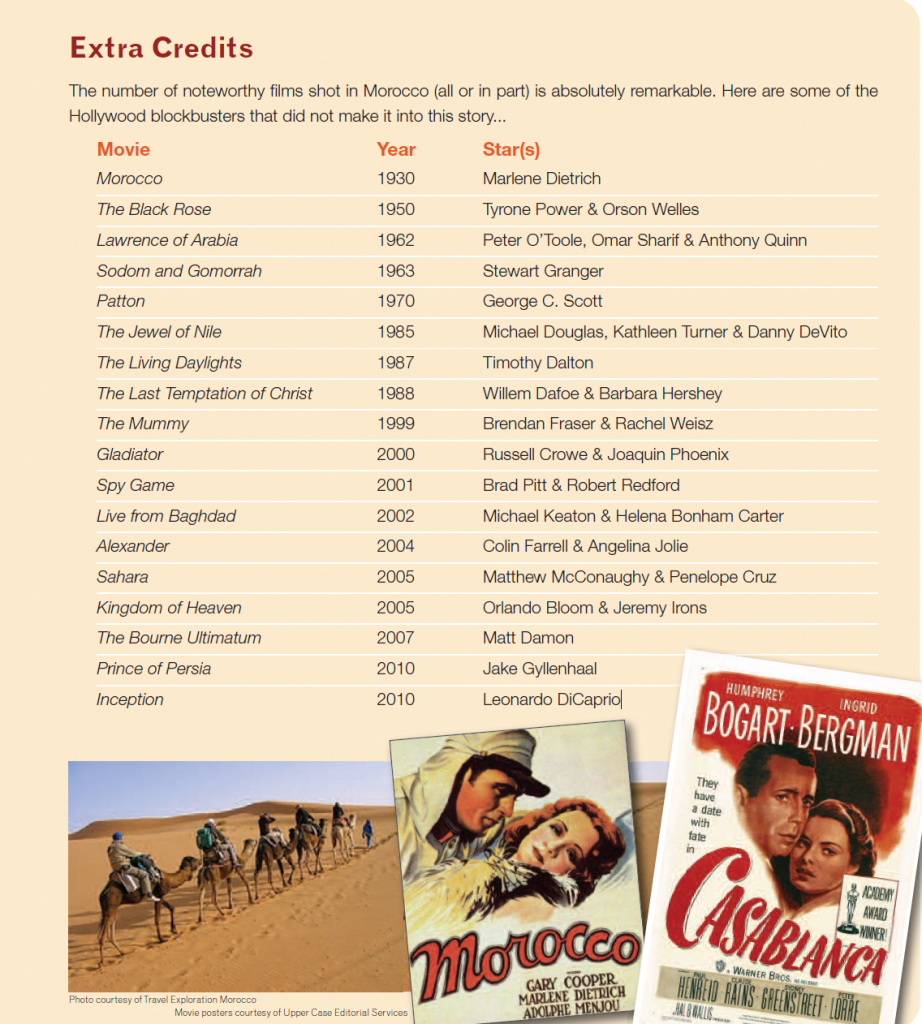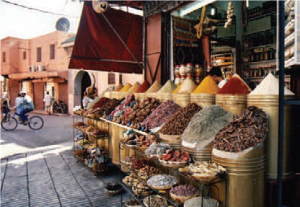When Hollywood needs a go-to country, it goes to Morocco
 Here come the choppers. Swirling into Mogadishu. Smoke, dust and sand fill the screen. Swarms of half-naked kids race past adobe buildings that explode into flames and deadly debris. Somalia never looked more hellish. The American Rangers never looked more battle-ready. It’s Blackhawk Down—based, of course, on actual events and directed by Ridley Scott, who is mighty pleased with his blockbuster film. Dramatically a winner, financially a dreamboat that, reportedly, earned its investors “ten bucks on the dime.” And filmed On Location. Switch to Lebanon’s land-mined desert. Leonardo DiCaprio, hands aloft in surrender, must outfox both the ill-advised CIA as well as the local terrorists.
Here come the choppers. Swirling into Mogadishu. Smoke, dust and sand fill the screen. Swarms of half-naked kids race past adobe buildings that explode into flames and deadly debris. Somalia never looked more hellish. The American Rangers never looked more battle-ready. It’s Blackhawk Down—based, of course, on actual events and directed by Ridley Scott, who is mighty pleased with his blockbuster film. Dramatically a winner, financially a dreamboat that, reportedly, earned its investors “ten bucks on the dime.” And filmed On Location. Switch to Lebanon’s land-mined desert. Leonardo DiCaprio, hands aloft in surrender, must outfox both the ill-advised CIA as well as the local terrorists.
It’s Body of Lies and we don’t have to worry about Leo’s ultimate success. It’s never in doubt. Also filmed On Location. On a less hair-raising note, let’s zoom in on Sarah Jessica Parker who, as Carrie Bradshaw, sits quaffing champagne, flanked by her faithful trio of gal-pals. She’s draped in radiant silks, legs akimbo, on a priceless oriental rug in the deepest recesses of the Shah’s palace in Saudi Arabia. Precise location? Undisclosed for security concerns. Again, filmed On Location. And let’s not overlook those intrepid swashbucklers: Sean Connery, Christopher Plummer and Michael Caine. Resplendent in Her Majesty’s gold braided, brassbuttoned Imperial uniforms, braving the blizzards of India’s Himalayan heights. It’s India-profound.
The British Empire is in full flower. The Man Who Would Be King, first conceived by that old imperialist himself, Rudyard Kipling, whose saber-rattling novel was lovingly transposed into film by John Huston. And, yes, filmed On Location. On Location. Magic words. They convey authenticity and sky-high budgets. They conjure up drama, adventure, exotica and romance with a capital R. Somalia, Lebanon, Saudi Arabia, India. No expense spared. And who stops to ask, “Yes, but what location?” The answer lurks in the rapidly rolling credits, just before the screen goes blank. Just before the lights come up and you’re reaching for your hat, the car keys and those missed messages on your cell phone. Or pushing the little square button on the remote. So no wonder you missed that split-second phrase that so graciously thanks King Hassan II or, more recently, King Mohammed VI and the People of Morocco. This is one of the film industry’s best-kept secrets, a secret that delights directors and accountants and—Surprise! Surprise!—delights even the pampered stars of stage and screen, who do not take kindly to life in the rough. Everyone who is anyone in the film industry, it seems, knows full well the advantages of shooting a film in Morocco.
Fooling the Camera For starters, there’s the easy accessibility to every kind of scenery. Snow-crested mountain peaks in the Atlas Mountains. Endless vistas of sandy shorelines, both Atlantic and Mediterranean. Boulder-studded canyons like Glaoui Kasbah, Ait Benhaddou Kasbah, and Valley of the Nomads. Cascading waterfalls, rushing rivers, tranquil lakes and infinities of golden Saharan sands. Remember that scene in The English Patient? There is Ralph Fiennes, the love-stricken English-speaking Hungarian spy. He has settled his wounded amour, Kristin Scott Thomas, the seductive Katharine, in the depths of an Egyptian cave far out in the Sahara. She’s gravely wounded. One last, long embrace. As defense against the inevitable dark, she has only a faltering flashlight and a tattered copy of Herodotus.
Off he sets across the endless desert sands seeking help. We see him silhouetted on the far horizon, staggering, parched, heat stricken, doomed. All around the desert folds and unfolds into time without end. A nine-Oscar triumph! But forget all that about Egypt. From start to finish it was made not in Egypt, but a thousand miles to the west, in Morocco. Another smash hit filmed On Location It’s not just that Morocco can provide lookalike landscapes that easily pass for the Australian outback, a Hopi reservation, the jungles of the Amazon or the icy passes of the winter-bound Ural Mountains. Have you even an inkling how many scores of films are made every year based on the Bible, the Torah or the Quran? Morocco has every holy answer from the Temple of the Pharisees to the stable of the nativity. And if you’re a filmmaker with a tight shooting schedule and a dicey budget, it does not hurt one whit that Morocco can truthfully claim 360 days a year of unpolluted sunshine.
A Nation of Extras The silver screen’s love affair with the country dates back to 1897, when that French film pioneer, Louis Lumière took his camera crew there to film Le Chevalier Marocain (The Moroccan Knight). Orson Welles chose Morocco as the setting for his filmed version of Shakespeare’s Othello. Alfred Hitchcock made The Man Who Knew Too Much in the lush city of Marrakech, Morocco’s mecca for luxury lovers, be they movie moguls or run-of-the-mill zillionaires. Not surprisingly, so many decades of movie making has worked a kind of mutation on the DNA of the people of Morocco. It seems as if every man, woman and child has worked as an extra (a delightful gimmick for supplementing a daily wage). When Martin Scorsese on a morning needed a huge crowd of palm-waving devotees to welcome the Saviour into Jerusalem in The Last Temptation of Christ, the crowd was easily whistled up on minimum notice.
He could have had his crowd barefoot or sandal-clad. Or a bit of both. Everyone arrived authentically garbed in robes lifted right out of the Gospels. When, that very afternoon, the schedule called for a mob of enraged citizenry shrieking for a crucifixion, the morning crowd had no trouble “switching allegiance.” Strikingly handsome Tahar Najoui, 40-ish, who works for Travel Exploration Morocco as an expert van driver, delights in transporting tourists, film crews and movie stars to every corner of his native land. He modestly admits to acting as an extra in “more films than I can count.” The maid who tidies your room in the Berber Palace Hotel has probably played in half a dozen filmed street scenes. Her kids have happily passed for street urchins in ancient Rome or child soldiers in some Central African civil war. Your bus driver probably marched with Alexander the Great or stormed the ramparts of a 12th century fortress. Casting epic films on location in Morocco is the least of a director’s worries.
French Connection The French, who for many years affectionately called Morocco their Protectorate, have long since pulled up colonial stakes and retreated back to chez-eux. But as is so often the case, their legacy is very much in evidence. The engineering marvel of incredible road networks that join sea to mountain to desert was actually built by the French Foreign Legion—once everywhere in evidence, but today a discreetly diminished presence. Arabic and Berber are Morocco’s first languages, but French is widely spoken; English, in no small measure thanks to the film industry, is coming on with lightning speed. The legacy of the French is seen in other subtle ways: The windows of the pastry shops in Fez, Rabat or Casablanca could pass for patisseries in the Rue de Rivolli or the Plâce Vendôme.
The women of Morocco, bareheaded or partially veiled, move with a feather-footed grace that typifies the Paris pedestrians. Where else in North Africa can one walk the streets unhassled, confident that the crowd in the bazaar or the souk will not suddenly turn into a mob of hostage-takers intent on flag-burning or a game of effigy hangman? In addition to great roads and a predisposition for street chic, the French also left their Catholicism, which mixes painlessly with Islam and Judaism. It’s an easy blending that conveys a very European feel to the whole country. Morocco manages to balance delicately as part-Islamic, part-Christian, part-Catholic, part-Protestant. Many (but not all) women wear head scarves but the top-to-toe burqa is an oddity. Women are welcome to drive cars, attend university and marry as they please. Secularity has the upper hand in Morocco which, alone among North African nations, is quietly funding a well-organized push to join the European Union.
Government Blessings Sunshine and incredible scenery are only part of the answer as to why movies and Morocco are such a good fit. Take a look at the coastline of North Africa. Traveling east to west, from Egypt to Libya to Tunisia, Algeria and finally Morocco. In every country political unrest, riots, arson, roadblocks and civil upheavals are daily fare. Morocco alone remains serene. By the same token, why subject Emily Blunt and Ewan McGregor to the indignities of the streets of Yemen when Morocco affords Yeman-y landscapes as good as (or even better than) the real thing? If you caught Salmon Fishing in the Yemen when it hit theaters, once again, you were on location in Morocco. “We are,” as a well-known guide pridefully told a bus full of Japanese tourists, “the Safest Door to the Desert.” With a keen nose for profit, the Moroccan government has gone overboard to eliminate red tape for movie-makers. No nasty tie-ups there about film permits. Applications are approved within 24 hours at pleasingly competitive prices, especially as compared to Europe or North America.
Furthermore, from the Mediterranean in the north of Morocco to the Sahara in the south, filmmakers can count on ready access to state-of-the-art camera equipment, experienced sound and lighting crews and catering services that will provide soufflé au chocolat, perfectly ripe Camembert or chilled to perfection Moet et Chandon—even in the far reaches of the Moroccan Sahara. No need to transport all that equipment or all those technicians from California. It’s already right there in Morocco, and available at prices that undercut all competitors. Cate Blanchett first visited Morocco when she traveled there to star in Babel. The film was a huge box office success. Whether it was the success of the film or the appeal of the country, who’s to say? But rumor has it that Australian-born Blanchett and her husband, Andrew Upton—who together act as co-directors of the Sydney Theatre Company—are now interested in setting up a similar theatrical company, probably in southern Morocco. True? Absurd? Who’s to say? But certainly for now, it’s safe to say that there will be plenty more films…as distinct from one another as Sex and the City and Saint Joan, lining up to be produced in Morocco…aka “The Other Hollywood” or, as we say in the trade, On Location.





